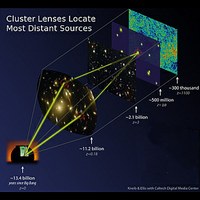In einer Entfernung von mehr als 13 Milliardne Lichtjahren steht die bisher entfernteste Galaxie!
Untersuchungsmethode:
Das Gravitationsfeld eines massereichen Galaxienhaufens wirkt als eine Gravitationslinse: Das Licht einer weit entfernten Galaxie wird durch diese Bündelung bis zu 20 mal verstärkt und erst dadurch für uns nachweisbar.
Auf diese Art konnten Galaxien beobachtet werden (Richard Ellis, California Institute of Technology), deren Licht 13,2 Milliarden Jahre zu uns unterwegs war. Als das Licht ausgesandt wurde, war der Kosmos gerade 500 Millionen Jahre alt.
300000 Jahre nach dem Urknall bestand der Kosmos noch aus dichtem heißem ionisierten Gas, das sich schnell abkühlte und neutral wurde. Erst die ersten Sterne oder Galaxien heizten das kalte Gas wieder so auf, dass es erneut ionisiert wurde. Ob die beobachteten Galaxien zu den ersten ihrer Art gehören?
"Damals" betrug die Tempertur des Kosmos nicht 2,7 K wie heute, sondern ca. 29 K und unser gesamter sichtbarer Kosmos hatte eine Ausdehnung von 1,3 Milliarden Lichtjahren, er war ca. 11 mal kleiner als heute (Rotverschiebung z = 10)
Bilder der Galaxien: Hier klicken!
Originaltext der Pressemitteilung:
Astronomers Claim to Find the Most Distant Known Galaxies
PASADENA, Calif.- Using natural "gravitational lenses," an international team of astronomers claim to have found the first traces of a population of the most distant galaxies yet seen-the light we see from them today left more than 13 billion years ago, when the universe was just 500 million years old.
Team leader Richard Ellis, the Steele Family Professor of Astronomy at the California Institute of Technology, will present images of these faint and distant objects in his talk on July 11 at the "From IRAS to Herschel and Planck" conference at the Geological Society in London. The meeting is being held to celebrate the 65th birthday of Royal Astronomical Society President Professor Michael Rowan-Robinson.
When light from very distant bodies passes through the gravitational field of much nearer massive objects, it bends in an effect known as "gravitational lensing." In a pioneering technique, the Caltech-led group used massive clusters of galaxies-the best example of natural gravitational lenses-in a series of campaigns to locate progressively more distant systems that would not be detected in normal surveys. The team found the galaxies using the 10-meter Keck II telescope, sited atop Mauna Kea on the Big Island of Hawaii.
Ellis explains, "Gravitational lensing is the magnification of distant sources by foreground structures. By looking through carefully selected clusters, we have located six star-forming galaxies seen at unprecedented distances, corresponding to a time when the universe was only 500 million years old, or less than four percent of its present age."
It is thought that when the universe was 300,000 years old it entered a period when no stars were shining. Cosmologists refer to this phase of cosmic history as the "Dark Ages." Pinpointing the moment of "cosmic dawn" when the first stars and galaxies began to shine and the Dark Ages ended is a major observational quest and provides the motivation for building future powerful telescopes such as the Thirty Meter Telescope, and the space-borne James Webb Telescope.
The new survey is the culmination of three years' painstaking observations which represent the thesis of Caltech graduate student Dan Stark. "Using Keck II, we have detected six faint star-forming galaxies whose signal has been boosted about 20 times by the magnifying effect of a foreground cluster. That we should find so many distant galaxies in our small survey area suggests they are very numerous indeed. We estimate the combined radiation output of this population could be sufficient to break apart (ionize) the hydrogen atoms in space at that time, thereby ending the Dark Ages," said Stark.
Proving definitively that each of the six objects is unambiguously at these enormous distances (and hence being viewed at such early times) is hard, even with the most powerful instruments. "As with all work at the frontiers, skeptics may wish to see further proof that the objects we are detecting with Keck are really so distant," confessed Ellis. However, in addition to numerous checks the team has made (described in their published scientific article) following their initial discovery a year ago, Ellis and Stark point to supporting evidence from galaxies containing old stars that are seen when the universe was just a bit older.
"We can infer the universe had a lot of star formation at these early times from Spitzer Space Telescope measurements of larger galaxies seen when the universe was about 300 to 500 million years older," explains Stark. "These galaxies show the tell-tale sign of old stars (and were described in earlier work by Ellis and Stark with UK scientist Andrew Bunker). To produce these old stars requires significant earlier activity, most likely in the fainter star-forming galaxies we have now seen."
Also associated with the program is Caltech postdoctoral scholar Johan Richard, who is leading a similar, but independent, survey of magnified galaxies detected with the Hubble and Spitzer space telescopes. Although that work is not yet complete, preliminary findings support the conclusions of the Keck II survey. European collaborators include Jean-Paul Kneib of the Laboratory of Astrophysics at Marseilles, and Graham Smith at the University of Birmingham.

